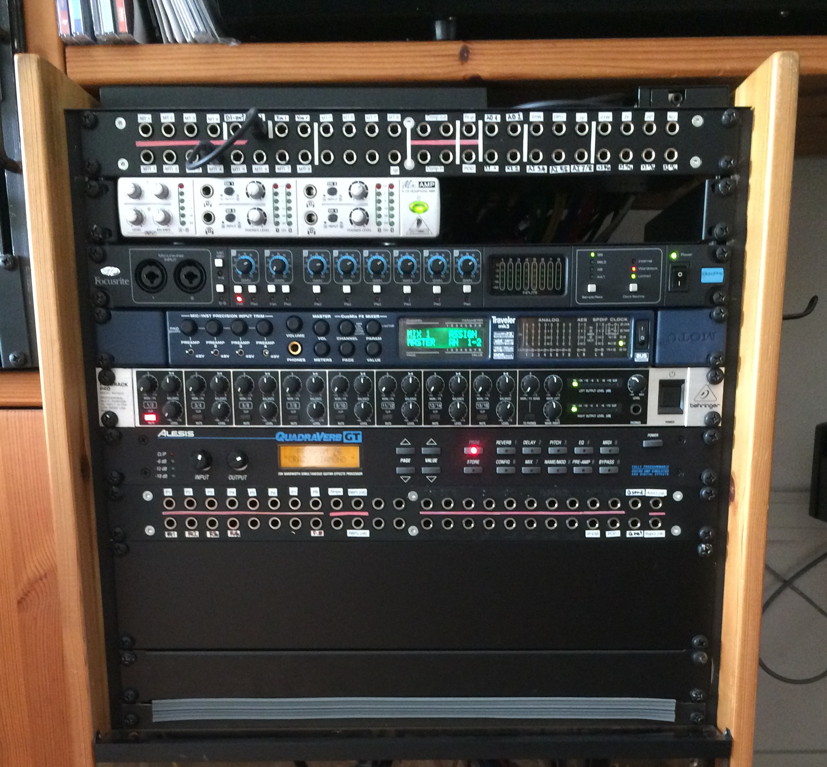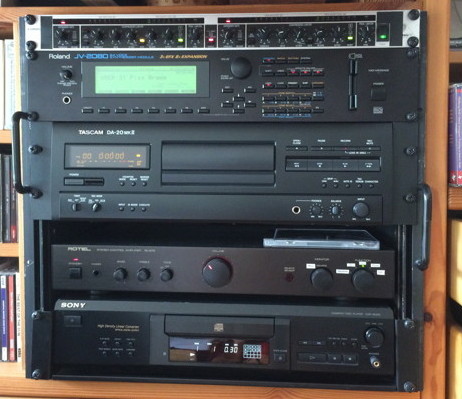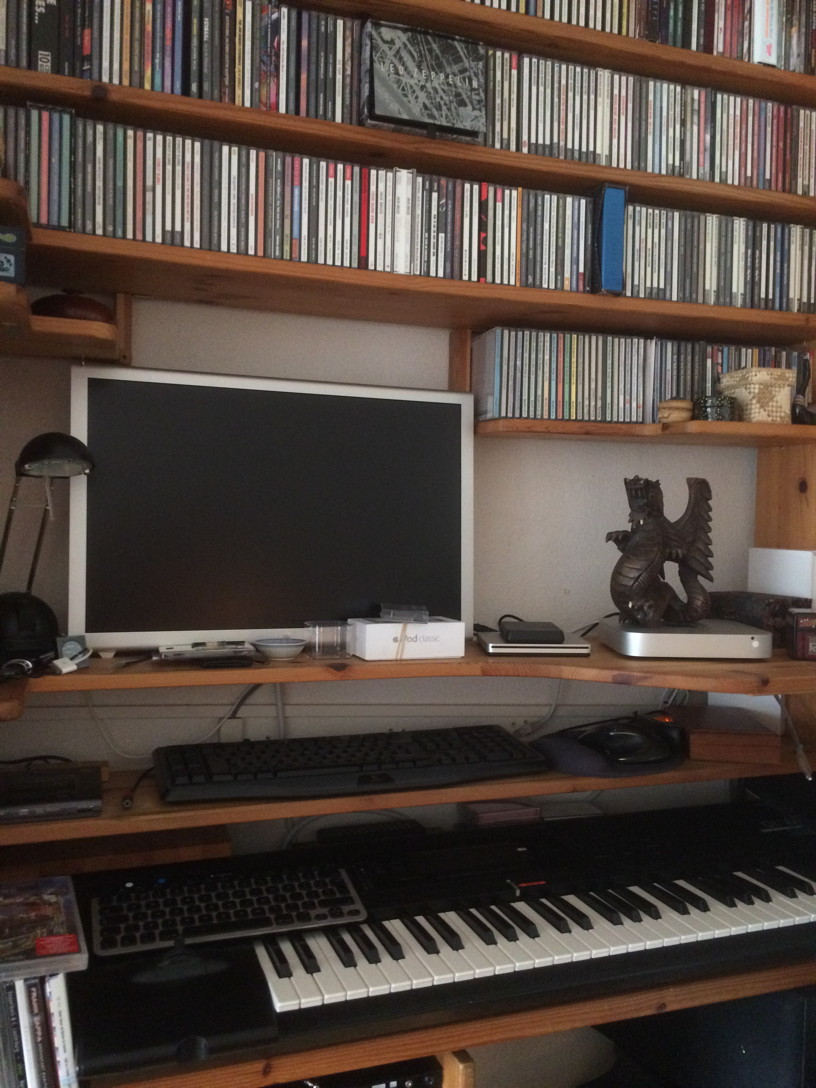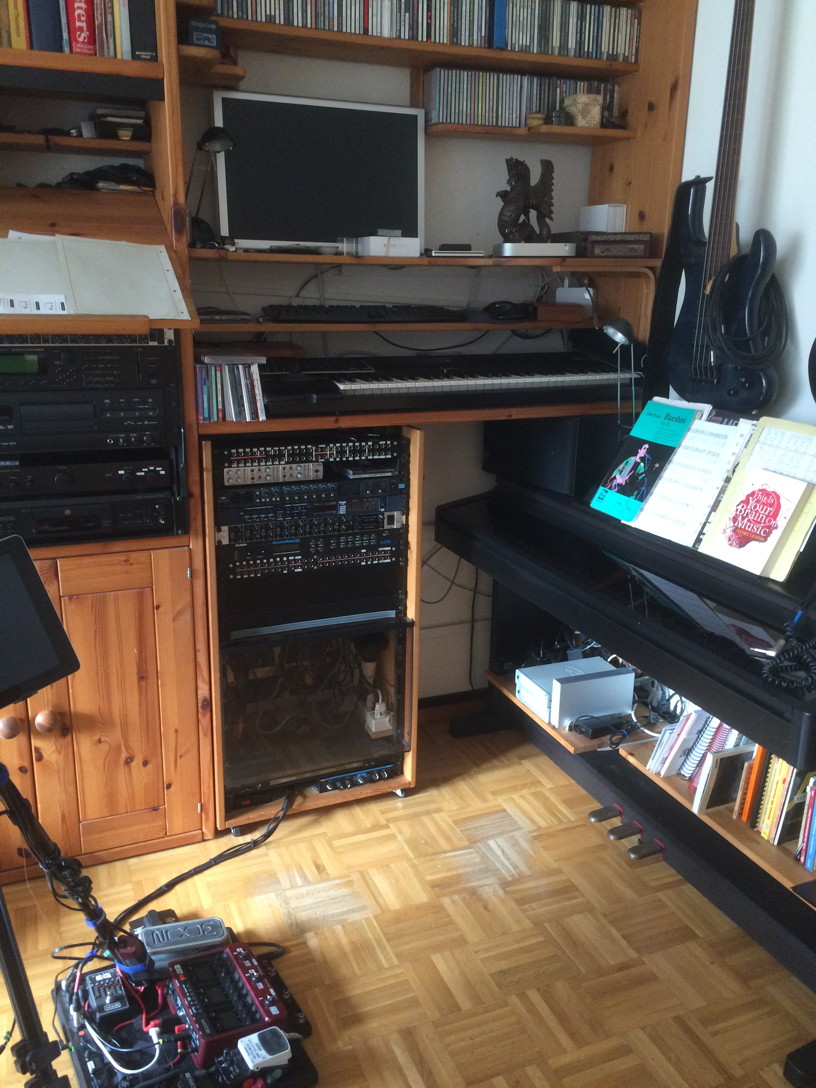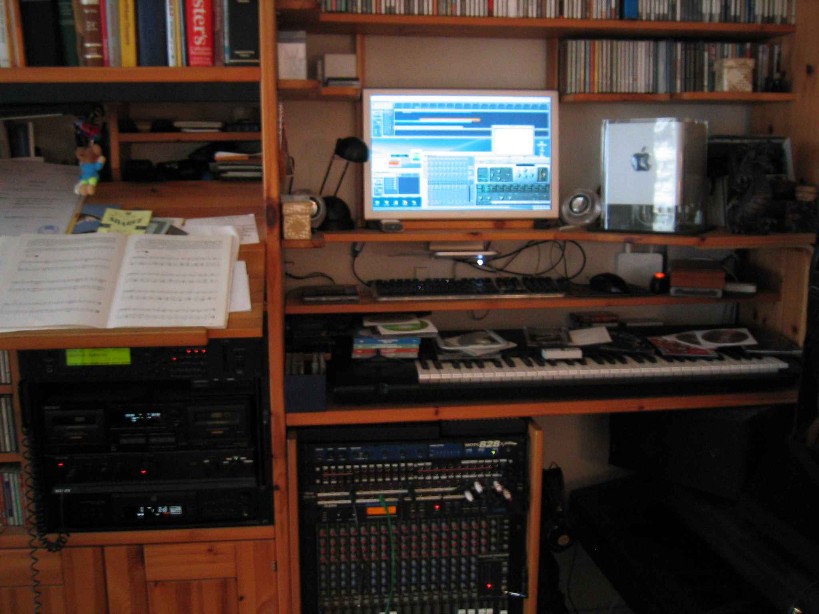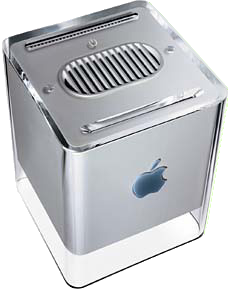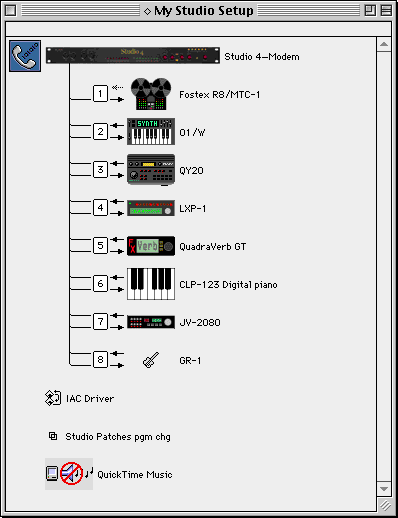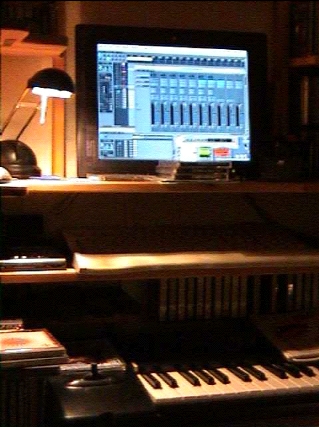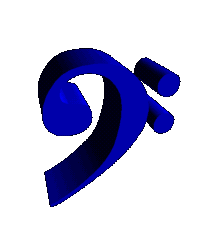My Music Studio:
Snapshots from the building phase...
A snapshot from the present (mostly digital mixing) showing both racks ...
|
Behringer Patchbay PX3000 (custom painted) Headphone amp Behringer AMP800 ADAT expander Focusrite OctoPre MkII MOTU Traveler mk3 Behringer EURORRACK RX1602 ALESIS QuadraVerb GT Behringer Patchbay PX2000 (custom painted) Fostex R8 (only top of cover visible) MOTU MIDI Express XT (not visible, below R8) |
Compressor Behringer Composer 2000 Synthesizer Roland JV-2080 DAT Tascam DA-20 MK II
Preamp ROTEL RC-972 (also connected to home theatre system) |
My main keyboards (left) and Overview of my current studio (right)
A snapshot from my previous studio based mostly on analog mixing...
Before...
A snapshot from once upon a time...
even earlier...
Some Components:
Note, deprecated components have a grey background(By the way they are mostly deprecated only due to software incompatibilites)
| Sound Modules | |||
| Korg 01/W Synthesizer (workstation) |

|
Master keyboard
PCM/Performance data: Orchestral (XSC-2S), Best of M&T (XSC-1S) |
|
| Roland JV-2080 Synthesizer (rack module) |

|
Expansions: Vocal (SR-JV80-13) Orchestral (SR-JV80-2) World (SR-JV80-5) Asia (SR-JV80-14) Keyboards of the 60's & 70's (SR-JV80-8) Vintage Synth (SR-JV80-4) Bass & Drums (SR-JV80-10) Hip-Hop (SR-JV80-12) 
|
|
| Yamaha Clavinova CLP-123 (home piano) |
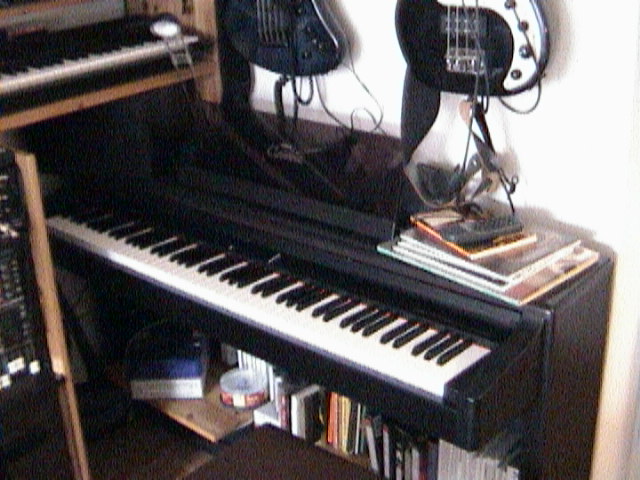
for enlarged view click here... |
Best keyboard in the studio, played by me, my daughter Sabina, and incidentally the cats (see snapshot at the top). | |
| Yamaha QY20 Synthesizer (portable sequencer) |
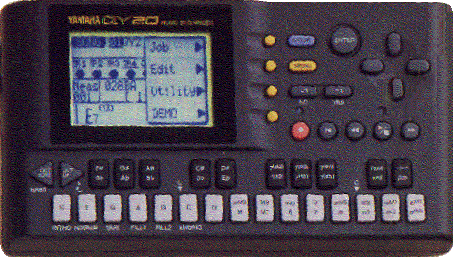
|
I use it to practice bass or if I'm on the move. If I practice bass it serves me as a drum computer or I play along the skeleton of a music piece stored in it's sequencer. All in all, it's a fine, sophisticated metronome, which functions independently of the computer (review). | |
| Recording, Digital Mixing, Sequencing | |||
| Fostex R8 |
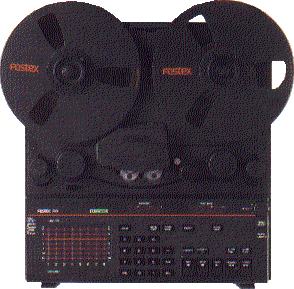
|
8 tracks, Dolby C NR
Actually, I own 2 Fostex R8. One is in use in the practicing room of the band, of course without a MTC-1. This is most convenient to carry only a tape back and forth between the studio and the rehearsel room. See MIDI Interface for further details on the use and the syncing of the R8 in my studio. Actually both my Fostex R8 are currently in repair. See my story to this here. I do not plan to use these machines much for recording anymore. Rather for playing back previously made recordings only while transferring them to the digital domain. |
|
| Tascam DA-20 MK II |

|
2 stereo tracks and digital coaxial S/PDIF connections to the Traveler mk3
I no longer use this DAT for mastering and prefer hard disk recording with CD burning as needed. I mostly use this device for playing back previously made recordings only while transferring them to the digital domain. |
|
Apple Mac mini server

|
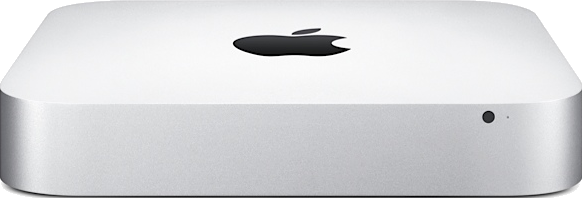
|
Digital mixing, MIDI sequencing, and hard disk recording system Hardware:
I also use this Mac to store my entire large music collection for listening via Home Sharing (Apple TV, Macs) and Audiotap on iOS devices, since Apple is unable to support
listening to large music collections with their buggy standard App "Music".
|
|
Apple Macintosh Power Mac G4 Cube

|
MIDI sequencing and hard disk recording system Hardware:
Software: Harddisk is partitioned into 4 partitions (configured using Intech ATA Hi-Cap Driver from Intech to overcome the 120 GB limitation):
I use:
All and precise details about the system under MacOS 9.2.2 used for audio and mastering (WaveBurner, OMS, Galaxy+ etc.) are shown here (configuration is frozen). This is the configuration for ordinary, i.e. non-audio computer use. |
||
MOTU
Traveler mk3

I formerly used: |

|
Is the cornerstone for digital mixing (Application "CueMix FX" or "TOuchOSC" from an iPad) and connects digitally (optical) to the ADAT expander Focusrite OctoPre MkII while still allowing for some analog mixing via the Behringer EURORACK PRO RX1602. This is giving me basically 32 analog inputs and 8 analog outputs for simultaneous use in my system. Moreover, some digital connections such as those to and from the DAT are available as well. The main output goes to the headphone amp input A. | |
| Focusrite OctoPre MkII |

|
This ADAT expander is connected via two optical cables with the MOTU Traveler mk3
and extends my digital mixing capabilities by adding another 8 high quality inputs. Each
input has a mic preamp and a combo connector for XLR or TRS balanced or unbalanced line
inputs. The two first inputs are on the front of the device and support connecting directly
high impedance instruments, e.g. my bass, or microphones. All mixing is done via MOTU's
"CueMix FX" application and the connection between the two devices is run at 96 Hz while
using Word clock from Traveler mk3 to the OctoPre MkII.
|
|
| Analog Mixing | |||
| Behringer EURORACK PRO RX1602 |

|
This analog mixer allows me to mix further 16 analog stereo signals that are present in my
music studio, complementing my digital mixing capabilities by adding another 16, i.e. 8
stereo, inputs. Therefore this device enables me to mix in the studio a total of 32 inputs without
any repatching. The single stereo mix coming out of this mixer goes by default (unpatched)
to the Traveler mk3 inputs 7 and 8 and the headphone amp input B. The mixer receives on its first 4 stereo
inputs all signals output from the Focusrite OctoPre MkII. Its
last 4 stereo inputs receive additional outputs from my synthesizers and the amp output of
the external HiFi system from our living room.
|
|
| Behringer Ultra-compact 4-channel Stereo Headphone Amplifier AMP800 |

|
Since I am missing the headroom I enjoyed during my Mackie mixer times with the current digital mixing, I added this little headphone amp. It gives me on the front as well as the back a 4 outlet connectivity to two outputs from my system (signal A: main out from Traveler mk3 as well as signal B: main out from EURORACK PRO RX1602). The link connection (signal A) goes to the external HiFi system from our living room. | |
| Patch Bays |

|
I have both patch bays painted so that they are black
|
|
| Mackie CR-1604 mixer |
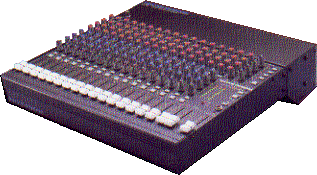
|
plus optional XLR-10, providing a total of 16 mic preamps.
Unfortunately my beloved Mackie mixer CR1604 is beyond repair. The main reason was bad contacts when listening through the headphone output, for me the most important main output. At low signal levels the left channel would not come through at all or after using the channel volume glider a few times, the signal came through but not clean with a lot of noise (crackling, in particular when the signal levels got temporarily low). A pity!! RIP! This meant welcome to the age of digital mixing using my Mac or an iPad. |
|
| MIDI | |||
MOTU
MIDI Express XT MIDI interface

I formerly used: |

|
MIDI interface / synchronizer To connect to the Mac, I use the USB port connection. To the Studio 4 I formerly used on the Cube the serial port CubePort from Griffin. Here the cabling I use to connect the analog tape recorder Fostex R8, Fostex MTC-1 tape recorder controller und synchronizer, MIDI interface, and the Mac computer running some MIDI recorder software (sequencer) such as Logic Pro 9:
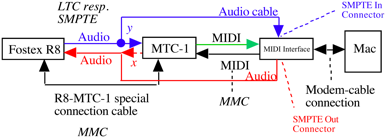
Blue (audio cables): Signal flow when Fostex R8 is used as sync-master and Logic MIDI sequencer is transport master sending MMC (MIDI Machine Control) signals. This cabling is made based on recommendations I found in the Logic manual first edition 1992/1993, p. 323; According to this recommendation the green MIDI connection (MIDI cable) between MTC-1 OUT to MIDI IN on the MIDI interface must not be made or you risk unpredictable behavior. Important: The Y-Connection from the R8's track 8 output sending SMPTE time code should not only be connected to the SMPTE input jack on the MIDI interface, but also to the SMPTE input of the MTC-1. Note, this connection y has to be present to ensure proper display of locations on the remote control of the Fostex R8. Red (audio cables): Signal flow used during striping, i.e. recording of SMPTE time code on track 8 of a new tape. Note: The connection x (red dashed) is no longer necessary. I used it only when striping with early Cubase versions, which triggered the MTC-1 to generate the SMPTE code. Today the preferred striping method is to use the MIDI Interface to generate the SMPTE code. Currently this means using the MOTU application "ClockWorks" (formerly "OMS Setup" while Studio 4 was in use). In general the connection x is to be dropped if another device than the MTC-1 generates the SMPTE code.
|
|
| External Effects, Dynamic Processors | |||
| Alesis Quadraverb GT |

|
Guitar multi-effects processor
Hints/Info:
|
|
| Behringer Composer 2000 |
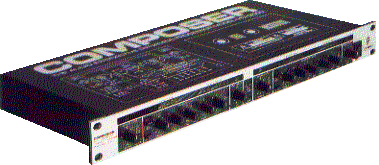
|
2-channel Compressor/Limiter/Expander | |
| Lexicon LXP/1 |
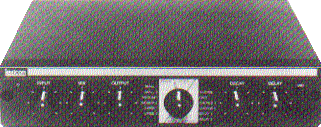
|
Lexicon's classic half-rack reverb (still in the rack, but disconnected)
Hints/Info: |
|
Snopshot made while downmixing with Logic...


